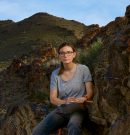
Olivia's work documented the severity of anoxia in basinal sediments from Vietnam on the south China platform at the Devonian-Carboniferous boundary, and postulated that massive volcanism could be a trigger for the Hangenberg Crisis. Her work on this topic was published in 2019:
- Paschall, Olivia C., Carmichael, Sarah K.,Waters, Johnny A., Koenigshof, Peter, Ta, Phuong H. Komatsu, Toshifumi, and Dombrowski, Allison D., 2019, The Hangenberg Event in Vietnam: sustained ocean anoxia with a volcanic trigger?, Global and Planetary Change (Special issue on Devonian global changes - recent advances and challenges in different domains, eds. G. Racki and P. Wignall), v. 175, p. 64-81 (DOI: 10.1016/j.gloplacha.2019.01.021) - click here for institutional repository copy with supplemental data
Olivia was also responsible for mapping the Hushoot Givetiin Gol in 2018 as part of a National Geographic expedition to southwest Mongolia. Her map was published in 2020 in a special issue of Palaeobiodiversity and Palaeoenvironments:
- Ariuntogos, M., Königshof, P., Hartenfels, S., Jansen, U., Nazik, A., Carmichael, S. K., Waters, J. A., Sersmaa, G., Crônier, C., Ariunchimeg, Y., *Paschall, O. C., and *Dombrowski, A. D., 2020, The Hushoot Shiveetiin gol section (Baruunhuurai Terrane): Sedimentology and facies from a Late Devonian island arc setting: Palaeobiodiversity and Palaeoenvironments (special issue: The Central Asian Orogenic Belt (CAOB) during Late Devonian: new insights from southern Mongolia) (DOI: 10.1007/s12549-020-00445-0)
Olivia is now working on her Ph.D. in geophysics at Cornell University.
(Ph.D. in progress, Cornell University; B.S. 2018, Appalachian State University)